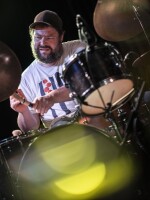
Kresten Osgood
Kresten Osgood has been playing music his entire life, starting on piano and drums before he was old enough to remember himself. On his journey with music, Kresten has played in large parts of the world and played all kinds of music ranging from marimba bands, African rhythms, organ combos (he recently began performing on the B3 as an organist himself), all kinds of jazz, improvised music, abstraction, hip hop, rhythm and blues and accompanying singer-songwriters.
As a drummer he has recorded with Paul Bley, Yusef Lateef, John Tchicai, Oliver Lake, Wadada Leo Smith, Kurt Rosenwinkel, Steven Bernstein, Ran Blake, Michael Blake, Jerome Cooper, Sam Rivers, Charles Davis, John Tchicai, Derek Bailey, Akira Sakata, Masabumi Kikuchi, Dr Lonnie Smith, Hugo Rasmussen, Bent Jædig and many others... He has performed with Bennie Maupin, Billy Preston, William Parker, Mat Maneri, Brad Mehldau, Eugene Chadbourne, Josh Redman, Jason Moran, Tony Scheer, Ladonna Smith and countless others.
He has hosted his own radio show (Osgood´s Jazz), as well as a children show, and was a panelist on the Danish TV show Smagsdommerne. He is part of the faculty at the Rhythmic Conservatory in Copenhagen and has composed music for his large ensemble Indianerne and music for a puppet theater. He has collaborated with dancers and poets, arranged his own festival and a symposium about contemporary music.
-
When the African-American improviser Luther Thomas arrived in Copenhagen, nobody knew who he was or cared. Thomas became a fixture of the alternative jazz scene and changed the music in Denmark. In an old slaughterhouse, Danish drummer Kresten Osgood opened "The Monday Club", which presented 6 concerts each Monday all year round for 7 years.
-
In this episode, we present a view of some of the main voices on the contemporary jazz scene. Among the artists covered are pianist Jeppe Zeeberg who tries to break the structure, and composer Jacob Anderskov who dreams of new structures. Whereas neo-traditionalists Nana Pi, Oilly Wallace and Johannes Wamberg work inside the structure.
-
Many of the young musicians in the early 90’s go to Boston to study. George Garzone is a teacher, Kurt Rosenwinkel a fellow student. They return to Denmark with new energy and fresh sounds. We hear about the two groundbreaking bands "When Granny Sleeps" and "Once Around the Park". We also tell the story of the OAP bassist Anders "AC" Christensen.
-
We dig deeper into the life of John Tchicai and tell the story about his time in New York (the first phone call being from John Coltrane). This episode also tells the story of the collaboration between Palle Mikkelborg and Miles Davis in 1985 (the second phone call being Miles calling Mikkelborg to tell him about the plans to make an album).
-
The world explodes in freedom, love and understanding. The jazz scene is forever changed as a band of hippies by the name of Blue Sun, toured Denmark opening for Jimi Hendrix. This episode also tells the story of saxophonist Lotte Anker, one of Denmark’s most internationally respected and visionary artists.
-
Portrait of the greatest drummer in Danish music: Jørn Elniff. He made history with Bud Powell, Oscar Pettiford, Eric Dolphy and Brew Moore. We tell the story of some of the legendary appearances by such artists as Earl Hines, Jimmy Smith, Clark Terry and many more. This episode contains explicit language.
-
This episode profiles three of the biggest personalities in the golden age of Danish jazz. Pianist, composer and vocalist Karen Jønsson struggles to be accepted, Leo Matthisen battles the Nazis during World War II, while Sven Asmussen is taken away by Gestapo to the central prison in Berlin for the crime of playing the violin.
-
The first saxophone in Danish music history arrives on a boat from America. The young Valdemar Eiberg tries with enthusiasm to play music he has hardly heard. Early visits from Sam Wooding and later Josephine Baker and Louis Armstrong divide the public but inspire the first generation of Danish jazz musicians to break new ground.

